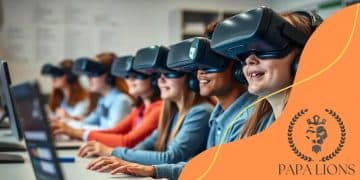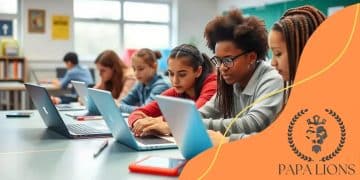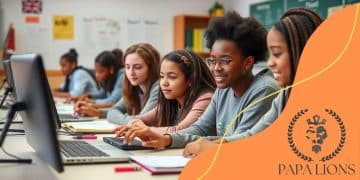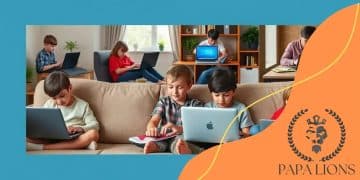How AR is being used for hands-on learning experiences
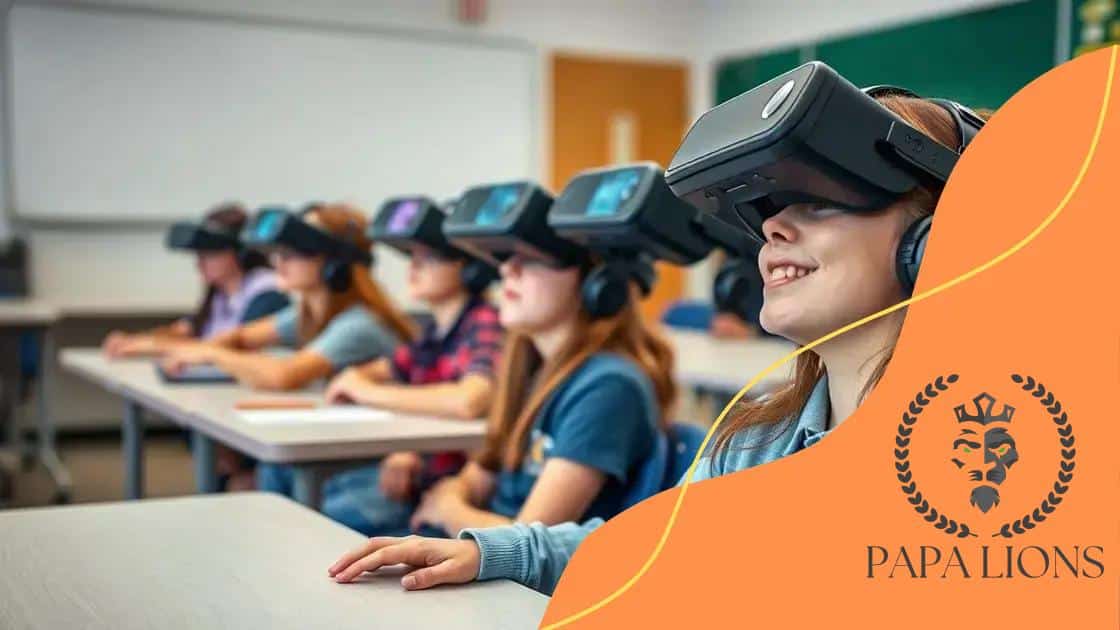
Augmented reality (AR) enhances hands-on learning experiences by providing immersive, interactive environments that support personalized education, improve engagement, and facilitate real-world applications across various subjects and skill levels.
How AR is being used for hands-on learning experiences is changing the way students engage with educational content. Imagine exploring the human body in 3D or walking through ancient history—all through your device. Curiosity piqued? Let’s dive in.
Understanding the basics of augmented reality
Understanding the basics of augmented reality (AR) is essential for grasping how it transforms learning experiences. AR blends digital information with the real world, creating interactive environments that can enhance education.
What is Augmented Reality?
Augmented reality is a technology that superimposes digital content, such as images and information, onto the physical world through devices like smartphones and tablets. This integration encourages active learning, allowing students to engage with materials in a hands-on way.
Key Features of AR in Education
- Interactivity: Students can interact with 3D models, fostering deeper understanding.
- Immersion: Immersive environments help maintain students’ attention and interest.
- Accessibility: AR can make complex concepts easier to grasp by visualizing them in real-time.
By using AR, teachers can create engaging lesson plans that captivate students’ minds. For example, in science classes, students can visualize biological processes or chemical reactions in a 3D space. This practical application reinforces learning concepts and makes them more tangible.
Moreover, AR promotes collaboration. Students can work together to solve problems or explore virtual scenarios, enhancing teamwork skills. This collaborative aspect is crucial, showing how technology can bring people together, even in a virtual space.
Examples of AR in the Classroom
There are many successful examples of AR in classrooms today. Some popular applications include:
- Google Expeditions: Virtual field trips that immerse students in environments worldwide.
- Merge Cube: A hands-on device for exploring AR experiences related to various subjects.
- Quiver: A coloring app that brings colored pages to life through AR.
These tools enable teachers to introduce innovative methods of instruction. As AR technology continues to evolve, the potential for use in learning will only expand, shaping how education is delivered and experienced.
The role of AR in STEM education
The role of AR in STEM education is revolutionary, providing unique opportunities for students to engage with complex concepts in science, technology, engineering, and mathematics. By incorporating augmented reality into STEM curricula, educators can create interactive learning experiences that make abstract ideas more tangible.
Enhancing Understanding of Scientific Concepts
AR allows students to visualize scientific phenomena, making it easier to grasp challenging concepts. For example, learners can explore the solar system or dissect a virtual frog, gaining insights that textbooks alone cannot provide. This immersive approach fosters curiosity, encouraging students to ask questions and explore further.
Engineering Simulations
In engineering classes, AR can simulate real-world scenarios where students design and test structures. They can see how their designs would perform under various conditions, which enhances critical thinking and problem-solving skills. AR tools can create virtual prototypes that allow for quick modifications, leading to better design and more efficient learning.
- Realistic simulations: Students experience scenarios that mimic real-life challenges.
- Immediate feedback: AR provides instant results, aiding in quick understanding and adjustment.
- Collaborative projects: Students can work together on virtual designs, building teamwork and communication skills.
Moreover, AR tools often include gamified elements that motivate students. By turning learning into a game-like experience, students are more likely to stay engaged and retain information. This approach not only makes STEM subjects fun but also accessible to diverse learning styles.
Incorporating AR into coding education allows beginners to visualize code effects in real-time. This real-time feedback loop supports learning and helps students understand the connections between coding and tangible outcomes. From creating animations to manipulating 3D objects, AR provides practical experiences that deepen understanding.
Preparing Students for Future Careers
As the demand for tech-savvy professionals increases, AR in STEM education prepares students for career paths that require advanced skills. By engaging with cutting-edge technology, students gain proficiency in tools that are increasingly relevant in the job market. This preparation helps bridge the gap between education and industry needs.
Enhancing language learning with AR
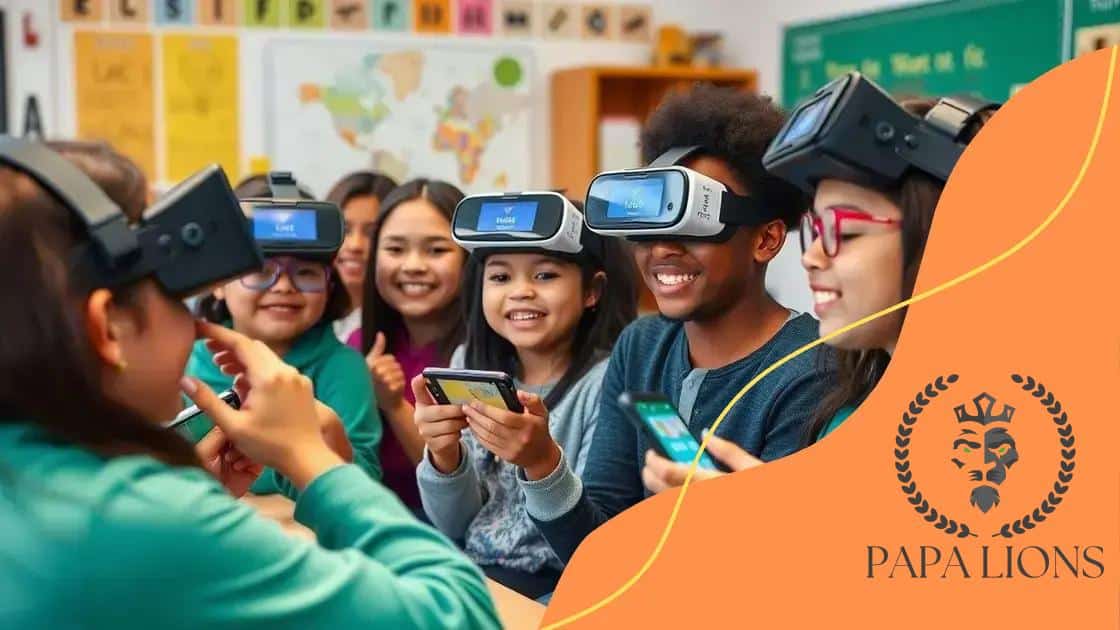
Enhancing language learning with AR provides students with immersive experiences that can accelerate their fluency and comprehension. Through augmented reality, learners can interact with language in new and engaging ways, transforming traditional methods into vibrant experiences.
Interactive Vocabulary Building
AR applications allow students to visualize vocabulary in real-world contexts. For instance, when they point their device at a common object, the app can display its name in the target language along with pronunciation tips. This method reinforces learning by linking words with their physical representations.
- Visual context: Seeing the word in context helps memory retention.
- Pronunciation practice: Listening to correct pronunciation aids in speaking skills.
- Engagement: Interactive features keep students motivated to learn.
Moreover, language learning through AR makes grammatical concepts easier to understand. Instead of merely memorizing rules, students can see examples in action. For example, AR can show how verbs change with different subjects or tenses, allowing students to grasp these concepts through visual representation.
Cultural Immersion
AR not only focuses on language mechanics but also on cultural elements. By using AR, students can explore traditions, landmarks, and customs related to the language they are learning. Virtual tours of foreign cities or interactive cultural festivals can cultivate a deeper understanding of the language in its cultural context.
Furthermore, this cultural immersion can spark discussions about the language’s nuances and idioms. When students engage with cultural content, they become more invested in learning the language, as it ties into their personal experiences and aspirations.
Incorporating gamified experiences through AR can also enhance motivation in language learning. Language apps often feature games that reward students for completing tasks or learning new phrases. This playful environment encourages users to practice consistently, knowing their efforts will lead to achievements.
Collaborative Learning Opportunities
AR facilitates collaboration among language learners. Students can work together on projects that require them to use the language actively. Through virtual group activities, they practice speaking, listening, and writing skills in a social setting. This collaborative aspect not only builds language skills but also fosters teamwork and communication.
As AR technology continues to evolve, the possibilities for language learning are vast. The combination of technology and education holds the potential for a more interactive, engaging, and effective approach to mastering new languages.
AR applications in vocational training
AR applications in vocational training are transforming how skills are taught in various fields. By using augmented reality, learners can engage in hands-on practice without the risks associated with real-world environments. This innovative approach helps students build confidence and competence in their respective trades.
Hands-On Skills Training
Augmented reality allows students to practice skills in a simulated environment. For example, in automotive repair training, students can interact with a virtual engine to learn about its components and functions. They can practice troubleshooting and repairs without needing a physical car, making the learning process safer and more effective.
- Realistic scenarios: Students face situations they might encounter in the workplace.
- Immediate feedback: AR provides instant assessments of performance, allowing for quick corrections.
- Accessible learning materials: Students can revisit complex topics at their own pace.
Moreover, AR can enhance training in healthcare fields. Medical students can use AR to visualize 3D anatomical structures, allowing them to practice surgical techniques in a safe environment. This interactive method helps reduce errors and improve patient outcomes when they enter the field.
Enhancing Technical Skills
In technical careers like plumbing or electrical work, AR enables trainees to see blueprints overlaid on real-world settings. This feature guides them through complex installations, ensuring they follow safety protocols and best practices. By integrating AR into training, students develop a stronger grasp of their craft.
Furthermore, AR promotes collaborative learning. Trainees can work in teams to solve problems, implementing skills learned in a supportive environment. Group projects foster teamwork and communication, vital skills in any vocational setting. These collaborative AR sessions prepare students for future workplace dynamics.
Preparing for the Future
The need for skilled workers is growing, making vocational training more essential. By incorporating AR technology, training programs equip students with modern tools that align with industry needs. This preparation allows graduates to enter the workforce with relevant skills and confidence.
As AR technology continues to advance, its applications in vocational training will only expand. By embracing these tools, educators can provide dynamic learning experiences that enhance skills and prepare students for successful careers.
Future potential of AR in education
The future potential of AR in education is immense, promising to transform how teachers and students interact with learning materials. As technology advances, augmented reality has the capacity to create more immersive and personalized educational experiences.
Personalized Learning Paths
One of the exciting prospects of AR in education is its ability to cater to individual learning styles. With augmented reality, students can choose their learning paths based on their interests and pace. For example, a student struggling with math can receive additional visual aids and interactive examples focused on their specific challenges.
- Adaptive content: AR can adjust the complexity of lessons based on student performance.
- Increased engagement: Hands-on activities keep students active and interested.
- Accessibility: AR can make learning resources available for students with disabilities, providing tailored support.
Furthermore, AR can bridge learning gaps by providing real-world context to abstract concepts. Students learning history can virtually tour historical sites, experiencing events as if they were there. This connection to real-life scenarios fosters deeper understanding and retention of knowledge.
Collaboration and Communication
As classrooms shift to include more technology, AR enhances collaboration among students. Group projects can benefit from AR, bringing teams together to work on tasks that blend their creativity and knowledge. By collaborating on AR platforms, students learn essential teamwork and communication skills.
Moreover, teachers can use AR tools to gather real-time feedback from students, assessing their understanding as lessons progress. This immediate insight allows educators to adjust their teaching strategies to meet students’ needs effectively.
Global Learning Opportunities
The potential for AR to connect students across the globe is also promising. By collaborating with peers from different countries, students can engage in cultural exchanges and share perspectives on various topics. This global interaction broadens students’ horizons, preparing them for a more interconnected world.
As AR technology continues to develop, its applications in education will expand. Innovations such as AR-enabled textbooks and interactive classroom experiences will revolutionize traditional learning environments. With these advancements, students will discover new ways to learn and explore, making education more engaging and impactful.
FAQ – Frequently Asked Questions about AR in Education
What are the main benefits of using AR in education?
AR provides immersive experiences that enhance engagement, support personalized learning, and allow students to explore complex concepts in real-world contexts.
How does AR support collaboration among students?
AR enables group projects and activities where students can work together in interactive environments, fostering teamwork and communication skills.
Can AR help with language learning?
Yes, AR enhances language learning by providing visual context and interactive vocabulary exercises, making it easier for students to understand and retain the language.
What is the future potential of AR in vocational training?
The future of AR in vocational training includes personalized learning, hands-on practice in safe environments, and preparing students for tech-driven job markets.
